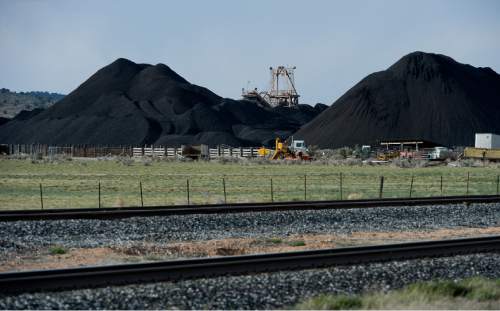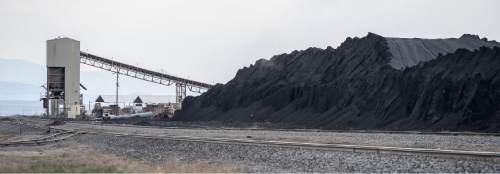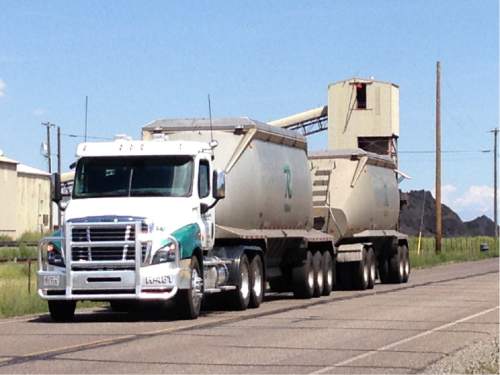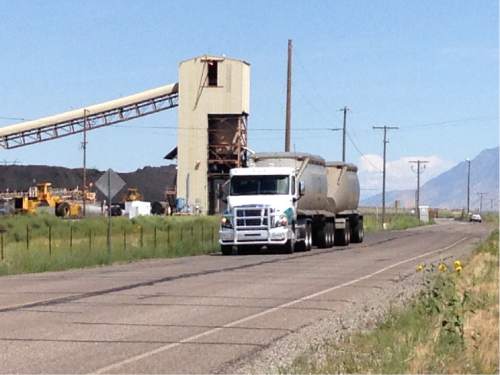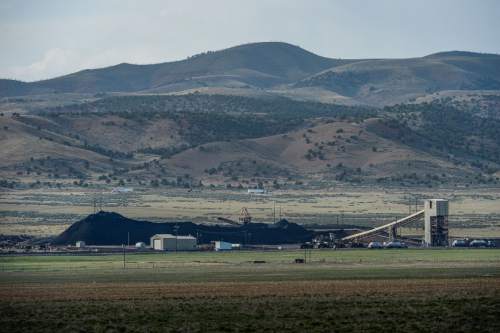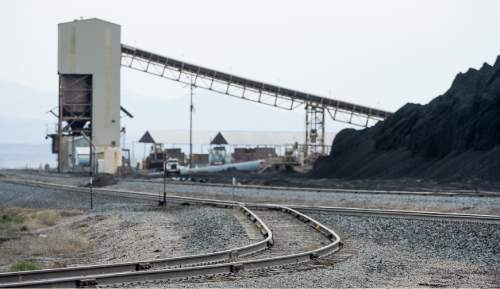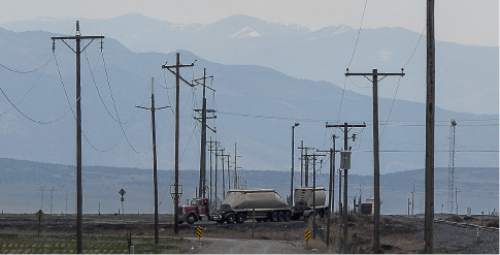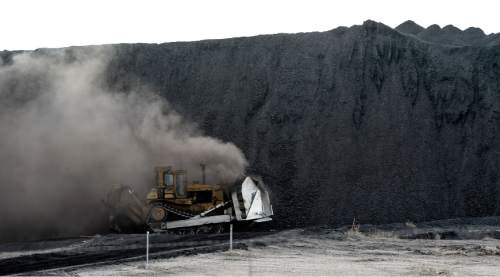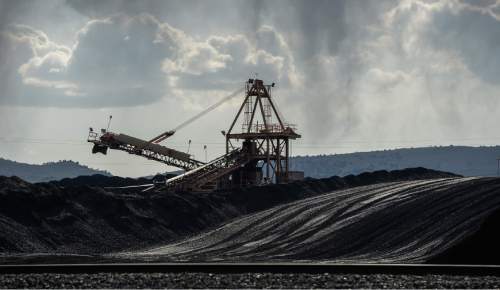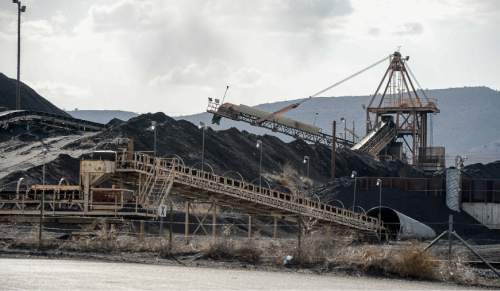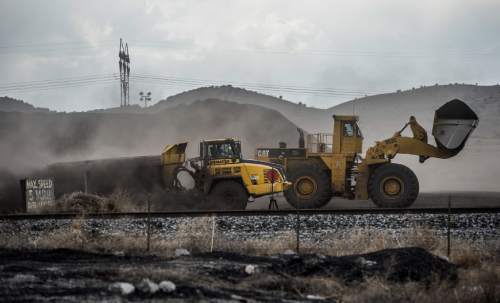This is an archived article that was published on sltrib.com in 2015, and information in the article may be outdated. It is provided only for personal research purposes and may not be reprinted.
Richfield • At a peak rate of one per minute, trucks carrying 43 tons of coal each from the Sufco mine travel the highway from Salina to a rail siding near Levan. Joining them is another steady parade of trucks loaded with salt from Redmond Minerals.
Travel to the distant rail connection increases costs and limits markets for those companies and others. It also wears ruts into the northbound side of State Road 28. The southbound lane is smooth because trucks returning empty are lighter.
All those heavy loads soon could be diverted onto a new 48-mile railroad — a long-sought line seen by local leaders as a missing link needed to attract new businesses to rural central Utah.
After 12 years of work, the proposed Central Utah Rail Project is expected to win final federal environmental clearance this month. But another big problem now looms: how to cover the rail route's projected $124 million price tag.
"I was always told that environmental approval is the toughest step," said Malcolm Nash, Sevier County economic-development director, noting he and others have worked on it since 2003. "We'll see if the next one is any easier, but it looks like a challenge, too."
—
Environmental impact • He told the Utah Transportation Commission in meetings in Richfield this week that the U.S. Surface Transportation Board is scheduled this month to issue a record of decision accepting plan changes made through a final environmental-impact statement.
"We started with a 43-mile alignment. It's now 48 miles, due to the environmental-review process," and changes made to avoid wetlands and other sensitive areas, Nash said. "It's added several million dollars to the project."
The lion's share of the proposed freight railroad's price tag would need to be paid by those who make shipments on it, he said. But changing economics make it unclear whether that will happen, or when.
When first proposed, the railroad was envisioned as a way to help sell more coal from Sufco (the area's largest employer) to other Western states and Asia — and do the same for salt from Redmond's mine, the area's clay products and hay (which has had a strong market in Asia).
"But the markets, primarily for coal, have changed," Nash told the transportation commission. Tougher proposed environmental regulations for coal have cut its market, but the railroad could be a lifeline to lower transportation costs and help Sufco survive.
"It's a tough regulatory environment right now," Nash said. "We'll wait and see."
—
Mine to port • The railroad could be the close-to-home link in a mine-to-port line ending in Oakland, Calif.
Sevier, Carbon, Emery and Sanpete counties want to invest in a new deep-water-port project in Oakland that would be the jumping-off point for shipments to Asia and Latin America. To that end, the counties recently won approval from the state Community Impact Board for a $53 million low-interest loan.
The project has drawn criticism in California from local government leaders who complain it is contrary to public policy pushing alternatives to fossil fuels. It also has raised questions about use of state mineral royalties from federal leases that are intended to mitigate the impact of mining on Utah communities. The port is the first out-of-state investment ever approved by the Community Impact Board.
Nash said the rail line is about more than coal. Redmond — which has been trying to expand sales of road de-icing salt to the Midwest — has lost contracts by tiny amounts, and the money that was saved by expanded rail transport could make the difference, he said. The new rail line would pass close to the Redmond salt mine.
"If the railroad is built, and that's a big if," it will depend on demand for freight, Nash said. "Freight railroads are financed because of the freight. It it's there, great. If not, it doesn't happen. They have to have the freight to do it."
He said that creates a bit of a chicken-and-egg predicament. Freight is needed to build the railroad, but businesses that would create more such freight won't come without the railroad in place.
"I've lost count of how many times a company is looking for rail in order to locate" here, he said. "We would fit all their other criteria. We just simply do not have rail. So we are hurt in our growth opportunities."
—
History • The area did have a rail line once, which ran through the Sanpete Valley along a different route. But floods and mudslides ruined stretches of it in 1983. Because it was old and couldn't carry modern heavy loads, it was abandoned.
Studies said reviving that old right of way would have been too expensive and impractical.
"Our area has suffered because of that" loss of the old railway, Nash said. Business leaders believe that until they have a railroad, he added, "we're just treading water."
The state transportation commission and Utah Department of Transportation have no role in approving the railroad (although UDOT would have some oversight once it is built), but cheered efforts for it in meetings and a tour of part of the proposed right of way.
Deputy UDOT Director Shane Marshall, for one, said maintaining State Road 28 has been an expensive challenge because of damage from the heavy-truck traffic, and the railway would solve that.
Nash told Marshall that studies predict the railroad would remove 89 percent of the road's trucks — even though projections say only one train a day would be needed to handle predicted freight loads.
Transportation Commission Chairman Jeff Holt praised rural counties for spending their own money to pursue the railroad for so long, and for seeking to improve transportation and business with it.
"It's incredible," he said.
Holt has a consulting contract with Sevier and its partner counties in the Oakland deep-water-port project, and he led their successful pitch for a $53 million loan from the state Community Impact Board.
Twitter: @LeeHDavidson


